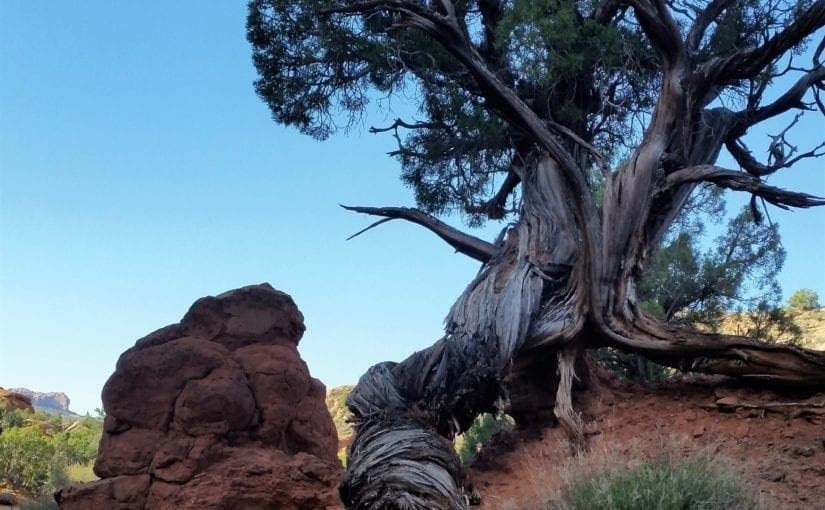Most recently updated July 31st, 2023
Estimated Reading Time: 15 minutes
When I was planning my Utah hiking trip, I asked for advice from hiker friends who had visited the area before:
Which National Parks should I visit? How much time should I allow for each park? Which trails are a must-do?

I was grateful for their insights, and found the advice to be mostly accurate – except for when it came to hiking Arches National Park.
Some feedback I got was that I didn’t need to plan for more than an afternoon at Arches National Park hikes, but we spent a day and a half there and still didn’t get to everything.
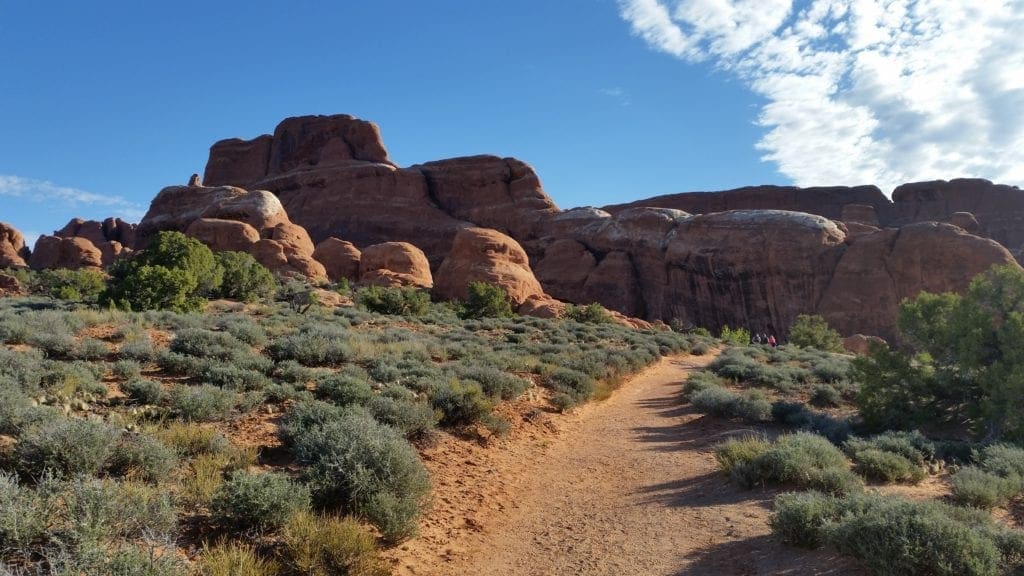
While it could be said that Arches isn’t very challenging for expert hikers, there’s no doubt that it is breathtakingly beautiful for everyone!
ARCHES NATIONAL PARK HISTORY
Arches National Park is located in southeast Utah: 5 miles north of Moab, Utah and 110 miles southwest of Grand Junction, Colorado, and bordered by the Colorado River on the Southeast side.
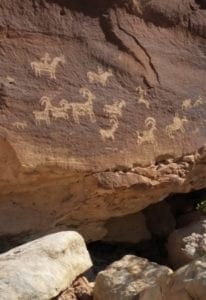
The Archaic peoples, followed by ancestral Puebloans, Fremonts and Utes, searched this desert area for animal and plant foods and stone to make tools and weapons.
Some of my posts contain affiliate links. If you make a purchase through an affiliate link, I will receive a small payment at no additional cost to you. I do not get paid for recommendations, all opinions on this site are my own. See full Disclosure page here.
A few panels of petroglyphs (on display in the park) are evidence of their passing. These Native Americans used this area for thousands of years.
The first non-native explorers came looking for minerals; cattle and sheep ranchers followed, lured by abundant grasses for feed.
The Wolfe Ranch, built and operated for 20 years by settler John Wesley Wolfe (a disabled Civil War veteran) and his son in the 1800s, still stands near the trail to Delicate Arch, providing a view into that part of the park’s history.

On April 12, 1929, after years of petitioning from prominent Moab residents, newspaper articles, and even letters from an area prospector, President Herbert Hoover signed presidential proclamation No. 1875 for the purpose of establishing Arches National Monument.
In 1971, Congress changed the status of Arches to National Park.
The park’s boundaries have expanded several times since it was first established to reach it’s current size, which encompasses 76,679 acres on the Colorado Plateau.
WHY SO MANY ARCHES?
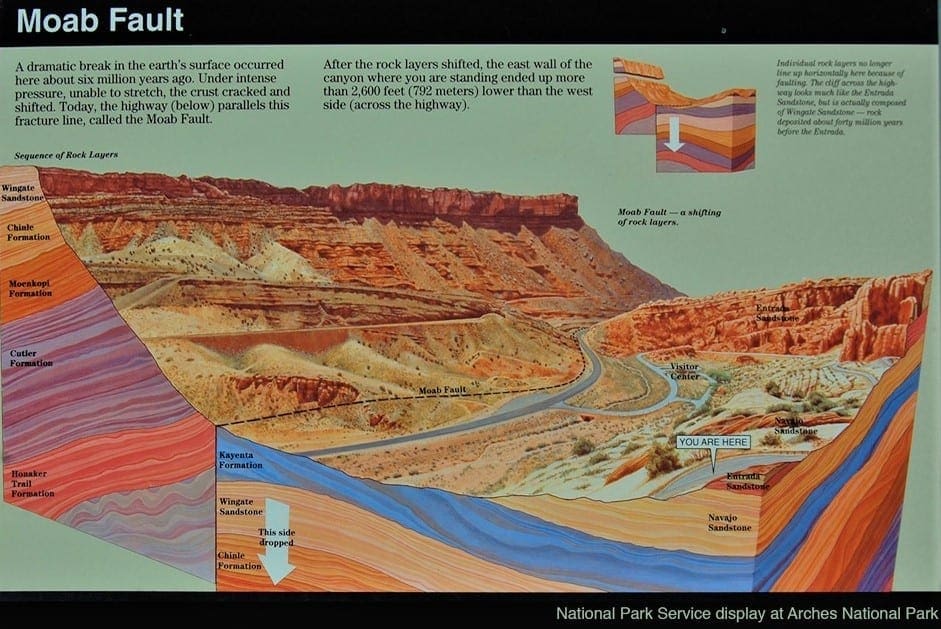
Long before there were any Arches in the park – roughly 300 million years ago – marine fossils in the Honaker Trail Formation tell us that the area was covered by an ancient sea.
If you visited the park a million years ago, it would’ve been an endless flat plain dotted with some sparse vegetation, above an underground salt-bed left behind by the sea.
The salt wasn’t a stable foundation for the layers of rocks over it, and the Moab Fault made the surface even more unstable.
Many years of wind, rain, and earthquakes changed the shape of the land, thrusting some rock layers upward as domes whiles others fell into the cavities.
Fast forward to 50,000 years ago, and the park was finally geologically stable, with formations very similar to the ones in the Park today.
In fact, there were many more arches back then than the 2000 that currently still stand.
Over time, the remaining formations will erode away as well, to be replaced by whatever new shapes are sculpted by wind and rain.
BEST TIME TO VISIT ARCHES NATIONAL PARK
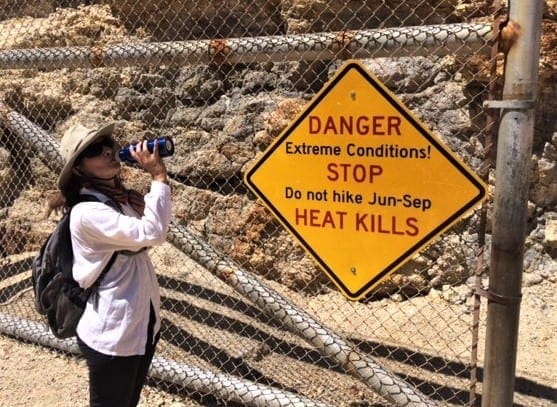
Arches is in a “high desert” region that experiences wide temperature fluctuations, sometimes over 40 degrees in a single day.
-
- Summer temps often exceed 100ºF, and late summer brings violent monsoons which often cause flash floods.
- Winters are fairly cold, with average highs 30º-50º F, and lows 0º-20º F.
Large snowfalls are uncommon, but even small amounts of snow or ice can make local trails and roads impassable.
The most popular times to visit are Spring (April through May) and Fall (mid-September through October), when highs average 60º-80º F and lows average 30º-50º F.
My visit to Arches National Park was in late April, and high temps were in the 80’s, which is moderate for the area.
The crowds were also moderate, since it was not a school holiday season. Both of these things made it a great time for a hiking trip.
WHERE TO STAY AND EAT
It’s important to note that there are no food options inside the park; you must pack food in if you want to eat during your visit.
There is also no lodging inside the park, but the Devils Garden campground (with water and flush toilets) is open all year. Reservations are required six months in advance.
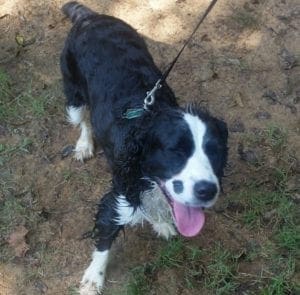
PETS: Pets are allowed in campgrounds and may be walked along roads and in parking lots (on a leash no longer than 6 feet), but they aren’t allowed on the trails, overlooks or anywhere in the back-country.
The town of Moab, just south of the park, offers plenty of hotels, restaurants and other visitor services.
We reserved our hotel room several months in advance.
ARCHES NATIONAL PARK VISITORS CENTER
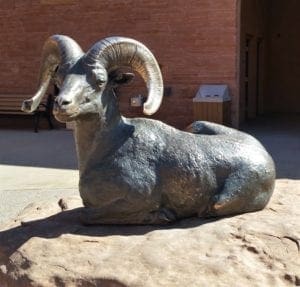
The park is open from 9am-4pm, every day of the year.
I recommend stopping at the Visitor Center first (open every day except December 25), especially if it’s your first time in the park.
You can ask a Ranger questions about any of the trails or viewing points, make reservations for ranger-led hikes, make a camping reservation or get a permit to hike in the Fiery Furnace area.
The Visitors Center also has educational displays, a general film about the park, and a small gift shop, as well as restrooms and water fountains.

We got there around 9am, after an early drive in from our hotel in Grand Junction.
I was interested in visiting the Fiery Furnace area, so I immediately checked to see if there were any Ranger-led hikes or permits available when we’d be in the park.
There were no places left on the Ranger hikes, but there was space early the next day for a permit. We quickly snatched it up!
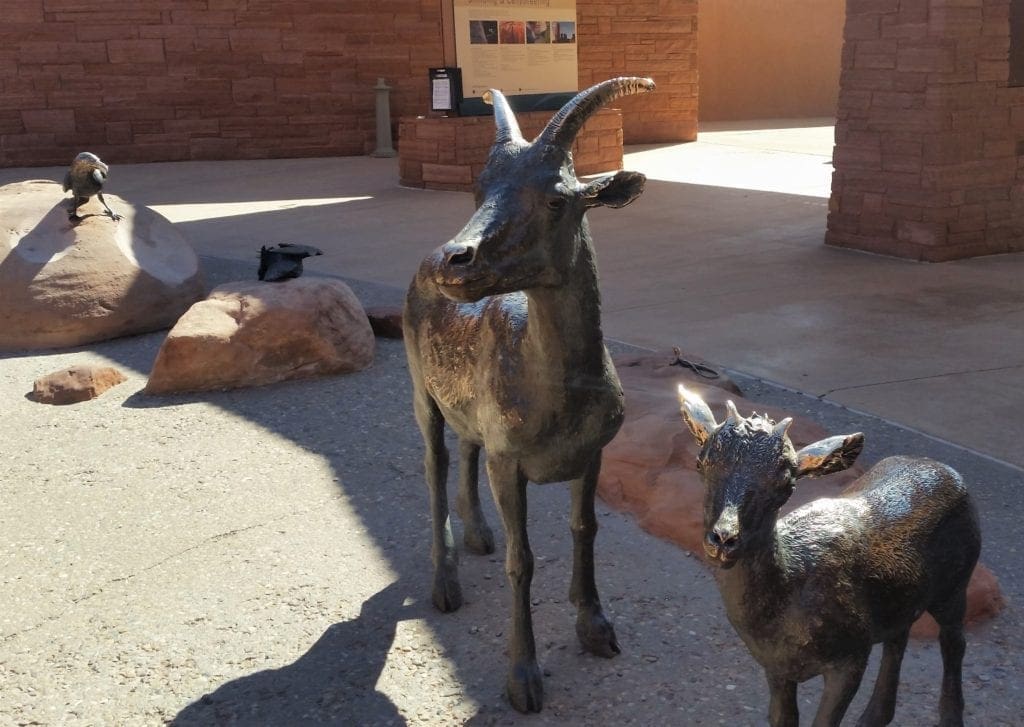
The other requirement to go into the Fiery Furnace area of the park is to watch a 30 minute orientation film, and sign a form agreeing to the visit rules.
The films are only offered a few times a day, and there was a showing in a few minutes.
We decided to wait and watch the orientation film right then, so we wouldn’t need to do it the next day.
ARCHES NATIONAL PARK TRAILS
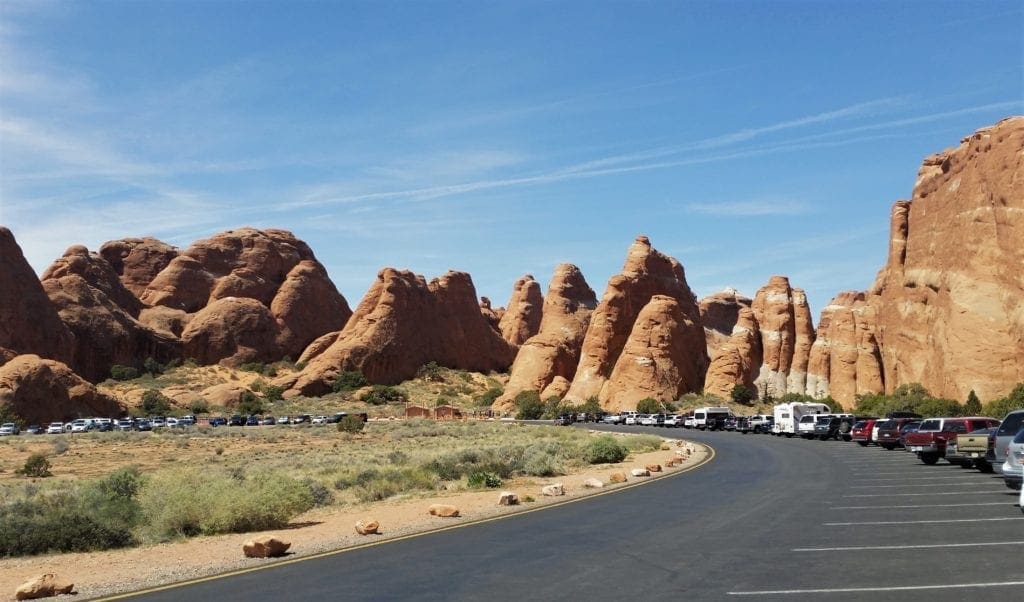
For any of the trails or viewing areas, you’ll need to drive to the appropriate trailhead.
Trailhead parking is very limited, and the only thing you can do if parking is full is move on and come back later.
For the best chance of finding a parking spot, it’s recommended you arrive before 9am or after 3pm.
There are hikes of Easy, Moderate, and Difficult levels at the park, mostly unpaved. Two shorter trails are accessible for wheelchairs.
To see a complete listing and description of Arches trails, click here.
The Easy and Moderate hikes wouldn’t be too hard for children, or most ambulatory adults.
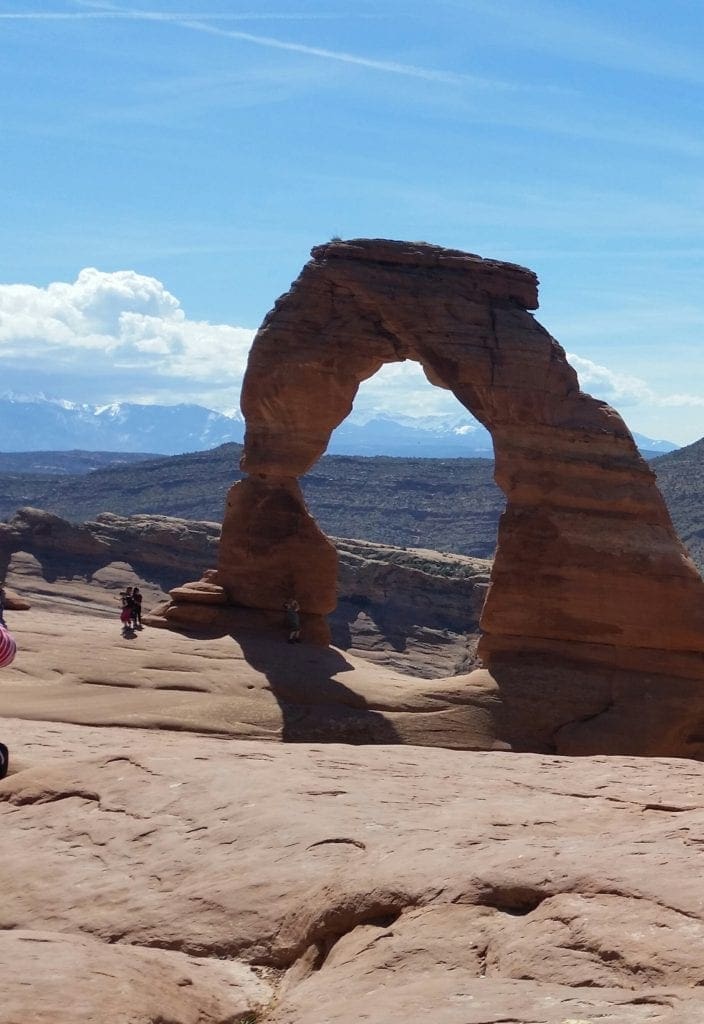
If you haven’t been on the trail for a while, you may want to train for a few weeks before you go, just to be sure you can enjoy all of the trails with no issue.
Because I’m an experienced hiker and we had limited time, I focused on the Difficult level hikes and will tell you more about the ones we hiked.
The one trail I was specifically interested in hiking, besides the Fiery Furnace, was the Delicate Arch trail, so we set out for that one first.
1) DELICATE ARCH TRAIL
This trail is 3 miles roundtrip, and will take you 1-3 hours depending on how fast you walk and how long you linger at the arch.
The Trailhead parking is right near the remnants of Wolfe Ranch and the Delicate Arch trail passes right by the ranch and the petroglyphs wall.
It’s definitely worth stepping off the trail for a few minutes to admire the handiwork of the ranchers and the Ancient peoples.
Follow stone cairns up the steep slickrock slope.
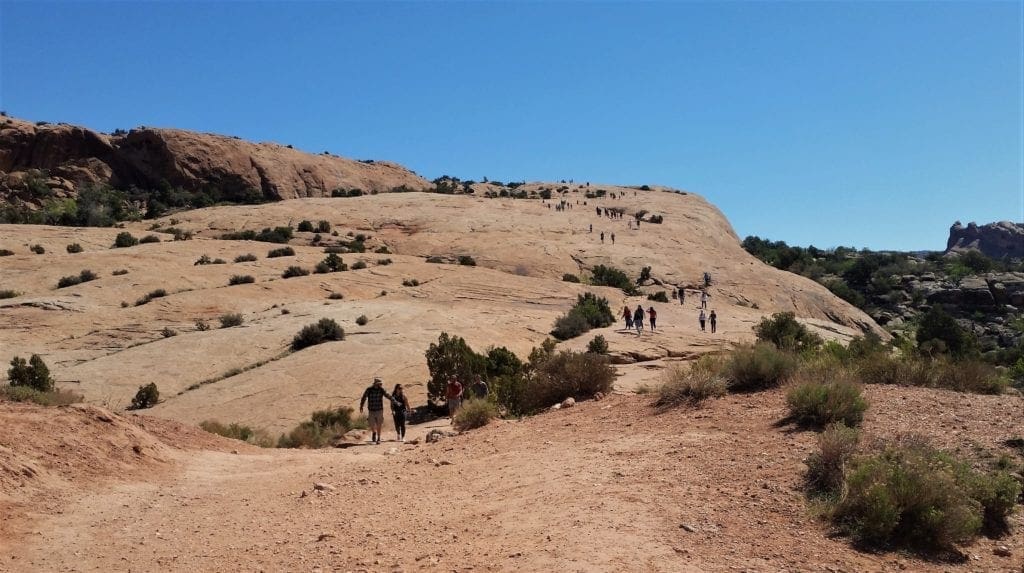
Elevation gain is 480 ft, the trail has no shade and just before you reach the arch it traverses a rock ledge for about 200 yards.
They recommend bringing 2 liters of water per person on this hike – and, as for all desert terrain parks, I recommend starting as early as you can in the morning to avoid the heat of the day.
The Arch is magnificent, and one you will recognize from photos of the area. This is well worth the hike!
Wear a hat and pack a snack, then spend some time soaking in the view before you head back down.
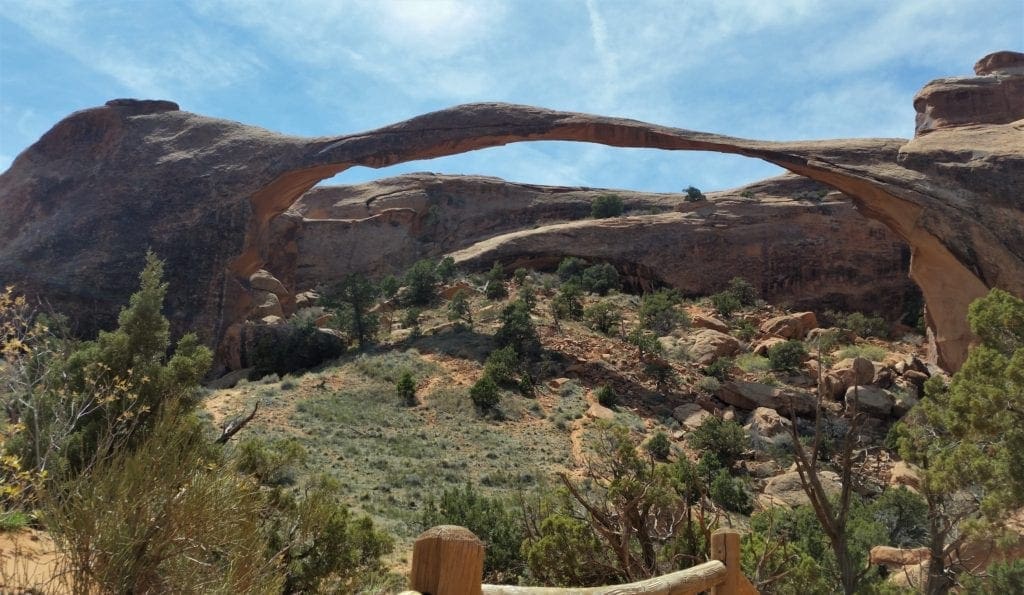
2) LANDSCAPE ARCH TRAIL (at Devil’s Garden)
This is another one you’ll have seen in photos.
Start at the Devil’s Garden trailhead, keep straight past signs for Tunnel Arch and Pine tree Arch and keep left at the fork (Primitive Trail is to the right.)
The 1.6mi roundtrip trail to Landscape Arch is actually rated Moderate difficulty, with a relatively flat hard-packed trail.
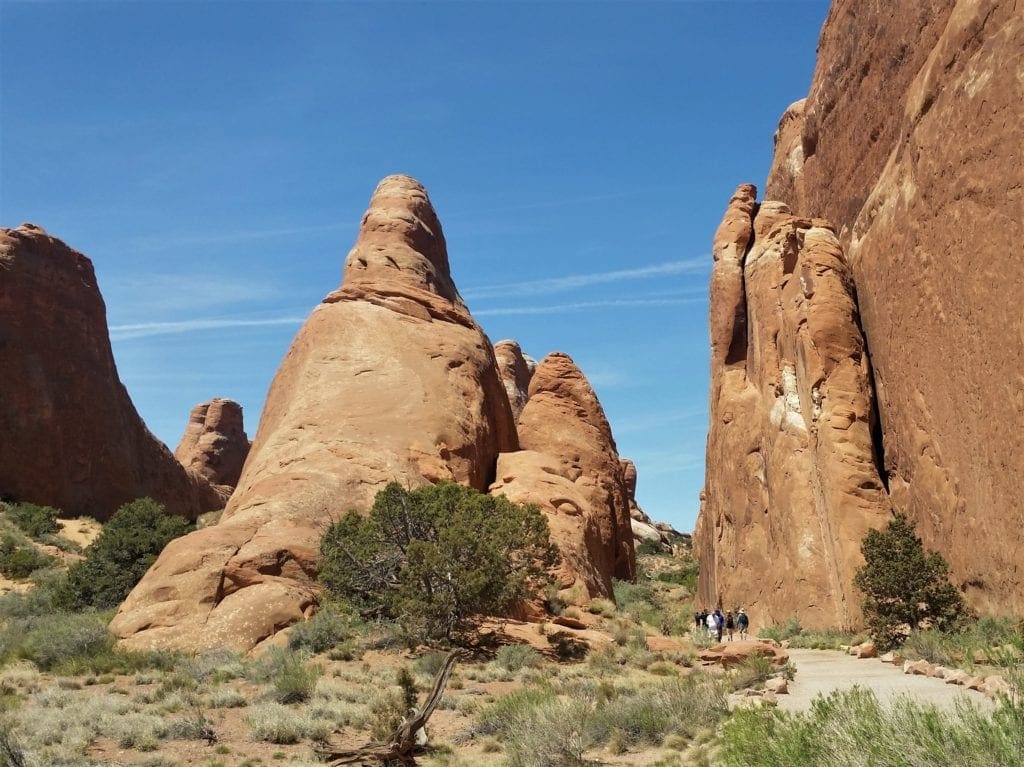
It should take you an hour or less to hike.
The Landscape Arch is getting ever more fragile; a rock slab 60 feet long, 11 feet wide and 4 feet thick fell from the arch in 1991, and another slab fell just a few weeks before I visited.
Be sure to see this one while it is still whole!
3) DEVIL’S GARDEN/PRIMITIVE TRAIL
This trail is rated Difficult, due to the primitive trail beyond Landscape Arch, and the length, which is 7.2 miles roundtrip if you do the whole thing.
You enter at the Devil’s Garden trailhead, and continue beyond Landscape Arch.
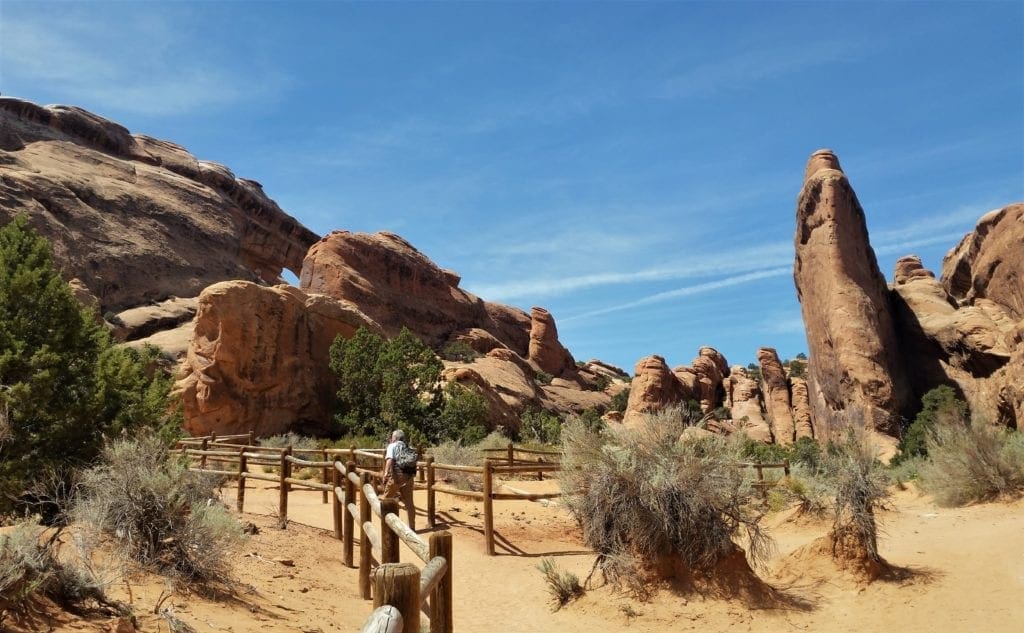
You will pass Partition, Navajo, and Double O arches before getting to the Dark Angel path.
Once you are beyond the sign for Dark Angel, if you keep going you will be on the Primitive Trail.
It hooks back up with the main Devil’s Garden trail back near Landscape Arch, and you can follow it back to the trailhead.
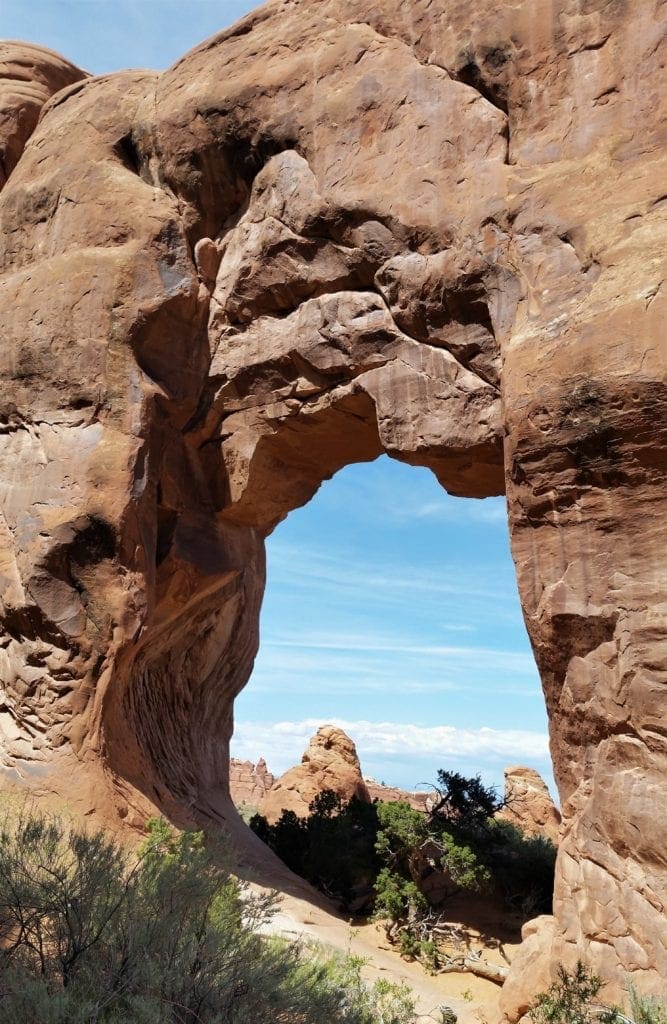
On the way back from Landscape Arch, Pine Tree Arch and Tunnel Arch will be to your left, if you choose to step off the trail to see them.
Keep in mind you don’t have to do the whole trail, you can turn around at any point along the trail up to Dark Angel.
Come back the same way you walked out to avoid the more difficult Primitive Trail side of the loop.
4) THE FIERY FURNACE (a.k.a. “The Floor is Lava”)

The Fiery Furnace is a natural labyrinth of narrow passages between towering sandstone walls.
The trail head is along the main park road towards the North side of the park, before you reach the Devil’s Garden trail head.
This area requires agility to explore, and is designated as a Difficult trail area.
Hike mileage will vary, depending on where you decide to go.
After you have your permit and assigned day, and have viewed the film and signed the rules sheet, you’ll be ready to go!
Before you hike, park at the Fiery Furnace trailhead, attach your permit to your backpack, and also put your special permit on your car’s dashboard.
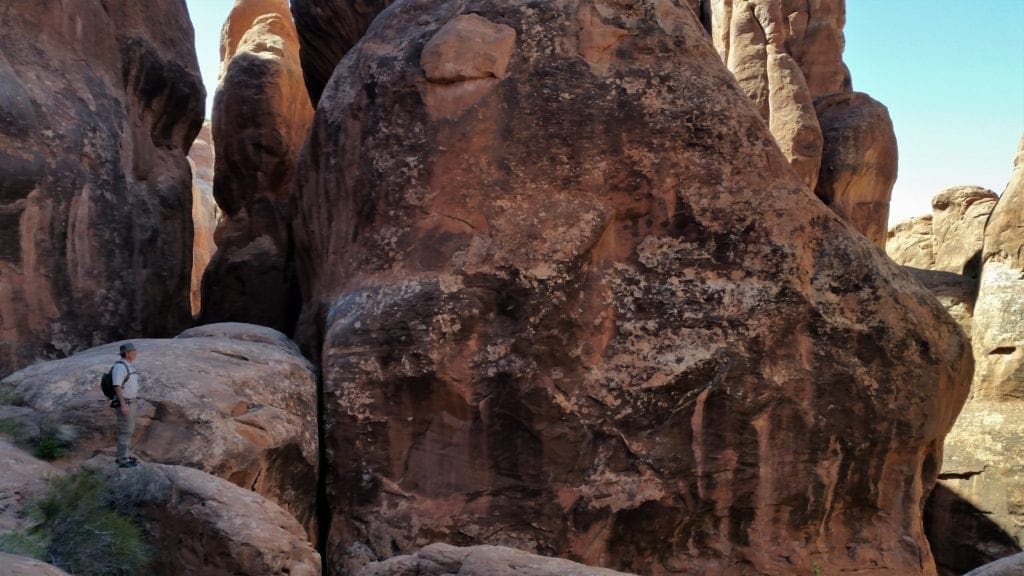
I recommend doing this as early in the day as you can to be sure you get a parking place and also to avoid the heat of the sun.
If you have gotten a space on a Ranger-led hike, show up at the appointed time with an ID and permit.
You can spend as long as you like in the Fiery Furnace, within the day on your permit, but you must be out by sundown; overnight stays in the FF area are not allowed.
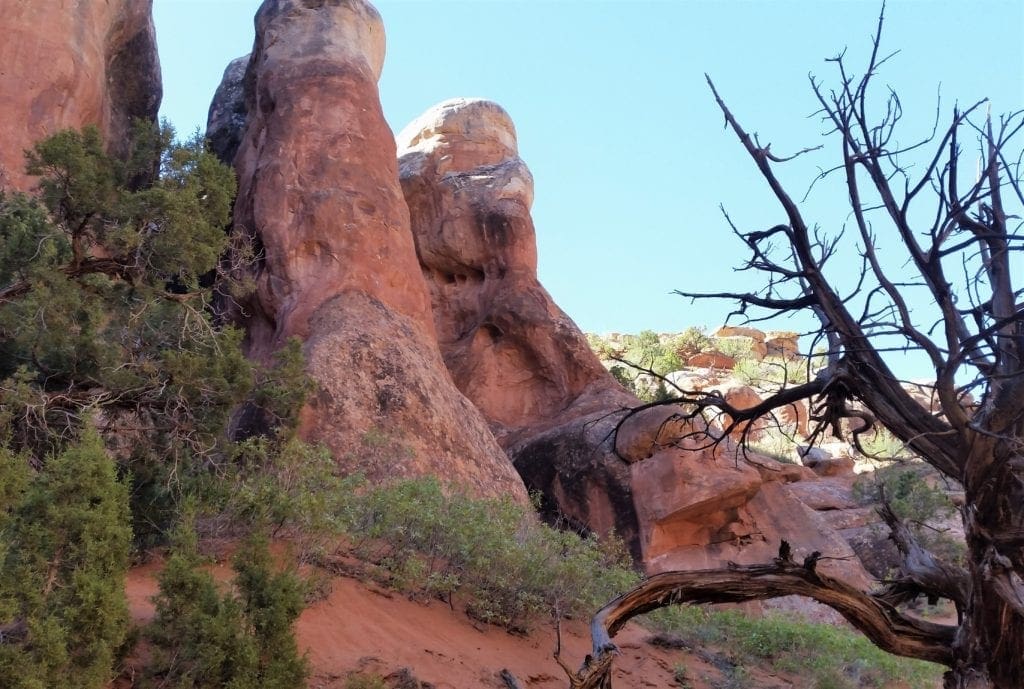
There are some small markers for one counter-clockwise route in the Fiery Furnace, but there are many other possible paths, and getting lost is a real possibility.
GPS does not work well due to the towering sandstone walls, so you must pay attention and remember where you came from.
Navigating the complex passages requires enough physical agility to scramble up stone towers and walk stone passages with your feet and hands on opposite sides of small crevices.
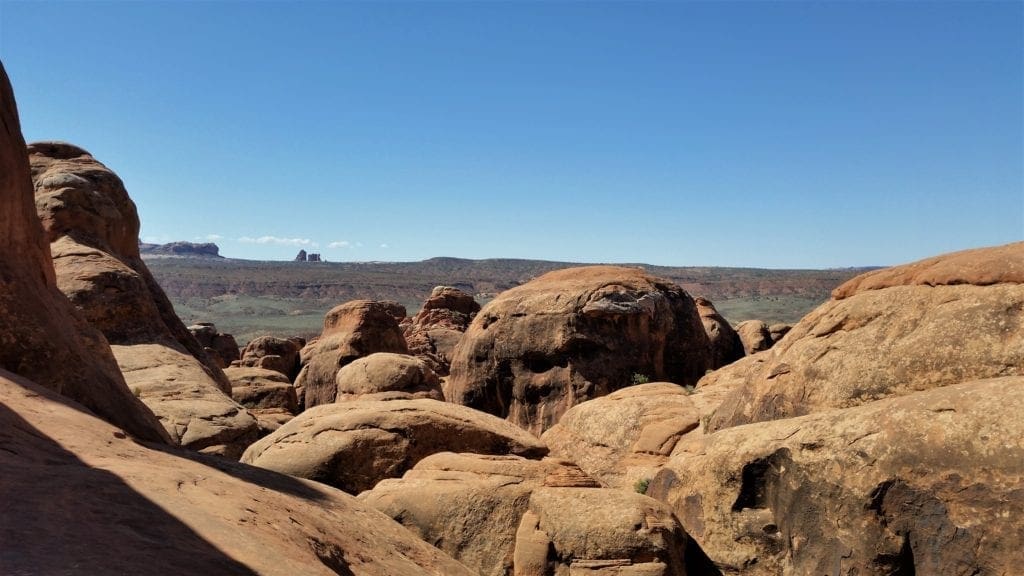
As noted in the permit film, to protect the wildlife and plants that inhabit sand dunes and drainages between the rock walls (the biologic crust), you’ll need to choose your steps wisely.
All of the rules make it sound like this is just too much trouble, but if you have the opportunity and the physical ability – do it!!
The Fiery Furnace was my favorite thing at Arches, even if we did have to back track a few times to avoid stepping on the living crust. (The floor is lava!!)
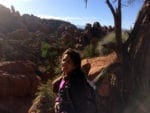
Arches National Park is a great place for a family trip, both because it has shorter trails (do-able for younger kids) and a lot of varied displays both on the trail and in the Visitor’s Center.
Another smaller Utah park, Bryce Canyon National Park, is also a great pick for a family trip – with shorter trails, and plenty of in-park lodgings.
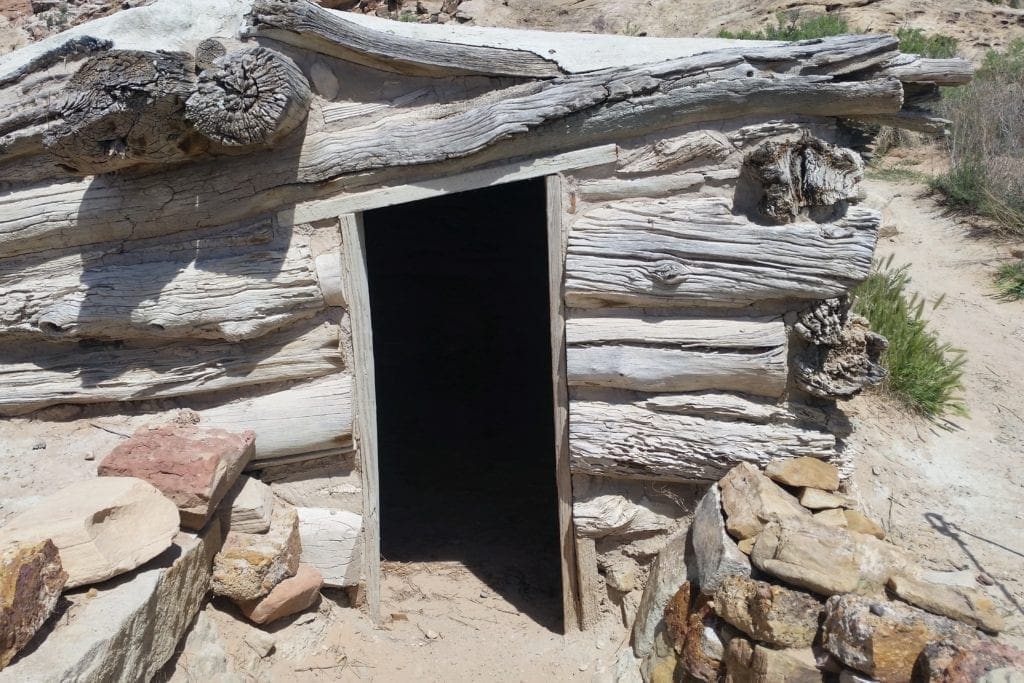
If you have a question drop me an email and I’ll reply as soon as I can.
If you’re interested in visiting other National Parks in different parts of the country, check out these articles:
If you’re looking for some travel pointers or ideas for your next adventure, check out my Travel Resources page.
I hope this post has inspired you to visit Arches National Park and try out some new trails!
If you have a question drop me an email and I’ll reply as soon as I can.
Thanks for stopping by – see you next time! LJ
To Get New Idratherwalk Posts
sent directly to your inbox (how convenient!) Click this Button
If you like this post, please share it!
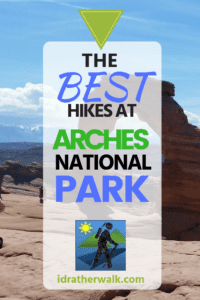
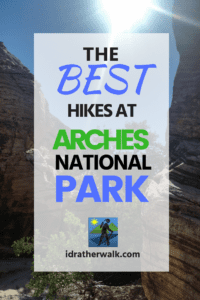
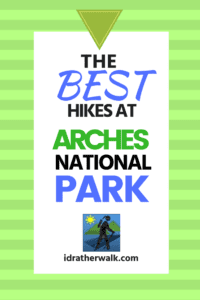
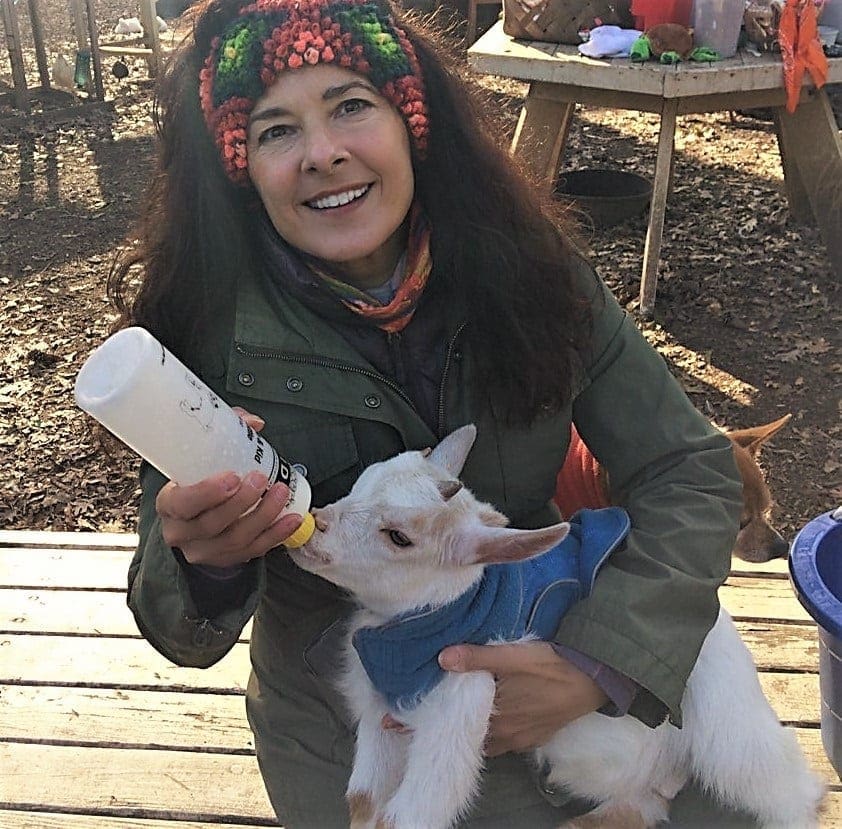
LJ has spent much of her free time as a single Mom – and now as an empty-nester – hiking in the US and around the world. She shares lessons learned from adventures both local and in exotic locations, and tips on how to be active with asthma, plus travel, gear, and hike planning advice for parents hiking with kids and beginners of all ages. Read more on the About page.

